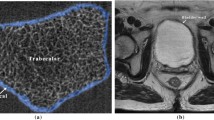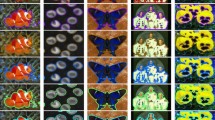Abstract
We describe a novel framework for two-phase image segmentation, namely the Fuzzy Region Competition. The functional involved in several existing models related to the idea of Region Competition is extended by the introduction of a fuzzy membership function. The new problem is convex and the set of its global solutions turns out to be stable under thresholding, operation that also provides solutions to the corresponding classical formulations. The advantages are then shown in the piecewise-constant case. Finally, motivated by medical applications such as angiography, we derive a fast algorithm for segmenting images into two non-overlap** smooth regions. Compared to existing piecewise-smooth approaches, this last model has the unique advantage of featuring closed-form solutions for the approximation functions in each region based on normalized convolutions. Results are shown on synthetic 2D images and real 3D volumes.
Access this chapter
Tax calculation will be finalised at checkout
Purchases are for personal use only
Preview
Unable to display preview. Download preview PDF.
Similar content being viewed by others
References
Bresson, X., et al.: Global minimizers of the active contour/snake model. No CAM Report 0504, UCLA, Dept. of Mathematics (2005)
Bresson, X., et al.: Fast global minimization of the active contour/snake model. To appear in Journal of Mathematical Imaging and Vision (2006)
Chambolle, A.: An algorithm for total variation minimization and applications. Journal of Mathematical Imaging and Vision 20(1-2), 89–97 (2004)
Chan, T.F., Esedoglu, S., Nikolova, M.: Algorithms for finding global minimizers of image segmentation and denoising models. UCLA CAM Report 04-54 (2004)
Chan, T.F., Vese, L.A.: Active contours without edges. IEEE Trans. on Image Processing 10(2), 266–277 (2001)
Fleming, W., Rishel, R.: An integral formula for total gradient variation. Archiv Der Mathematik 11, 218–222 (1960)
Jehan-Besson, S., Barlaud, M., Aubert, G.: Dream2s: Deformable regions driven by an eulerian accurate minimization method for image and video segmentation. Int. Journal of Computer Vision 53(1), 45–70 (2003)
Knutsson, H., Westin, C.F.: Normalized and differential convolution: Methods for interpolation and filtering of incomplete and uncertain data. In: Proc. of Computer Vision and Pattern Recognition, New York City, USA, June 16-19 1993, pp. 515–523 (1993)
Mumford, D., Shah, J.: Optimal approximations by piecewise smooth functions and associated variational problems. Comm. on Pure and Applied Mathematics 42(5), 577–685 (1989)
Osher, S., Sethian, J.A.: Fronts propagating with curvature dependent speed: algorithms based on the hamilton-jacobi formulation. Journal of Computational Physics 79, 12–49 (1988)
Paragios, N., Deriche, N.: Geodesic active regions and level set methods for supervised texture segmentation. Int. Journal of Computer Vision 46(3), 223–247 (2002)
Shen, J(J.): A stochastic-variational model for soft mumford-shah segmentation. International Journal of Biomedical Imaging 92329 (2006)
Tsai, A., Yezzi Jr., A., Willsky, A.S.: Curve evolution implementation of the mumford-shah functional for image segmentation, denoising, interpolation, and magnification. IEEE Trans. on Image Processing 10(8), 1169–1186 (2001)
Vese, L.A., Chan, T.F.: A multiphase level set framework for image segmentation using the mumford and shah model. Int. Journal of Computer Vision 50(3), 271–293 (2002)
Young, I., van Vliet, L.: Recursive implementation of the gaussian filter. Signal Processing 44, 139–151 (1995)
Zhao, H.K., et al.: A variational level set approach to multiphase motion. Journal of Computational Physics 127, 179–195 (1996)
Zhu, S.C., Yuille, A.: Region competition: Unifying snakes, region growing, and bayes/mdl for multiband image segmentation. IEEE Trans. On Pattern Analysis and Machine Intelligence 18(9), 884–900 (1996)
Author information
Authors and Affiliations
Editor information
Rights and permissions
Copyright information
© 2007 Springer Berlin Heidelberg
About this paper
Cite this paper
Mory, B., Ardon, R. (2007). Fuzzy Region Competition: A Convex Two-Phase Segmentation Framework. In: Sgallari, F., Murli, A., Paragios, N. (eds) Scale Space and Variational Methods in Computer Vision. SSVM 2007. Lecture Notes in Computer Science, vol 4485. Springer, Berlin, Heidelberg. https://doi.org/10.1007/978-3-540-72823-8_19
Download citation
DOI: https://doi.org/10.1007/978-3-540-72823-8_19
Publisher Name: Springer, Berlin, Heidelberg
Print ISBN: 978-3-540-72822-1
Online ISBN: 978-3-540-72823-8
eBook Packages: Computer ScienceComputer Science (R0)




